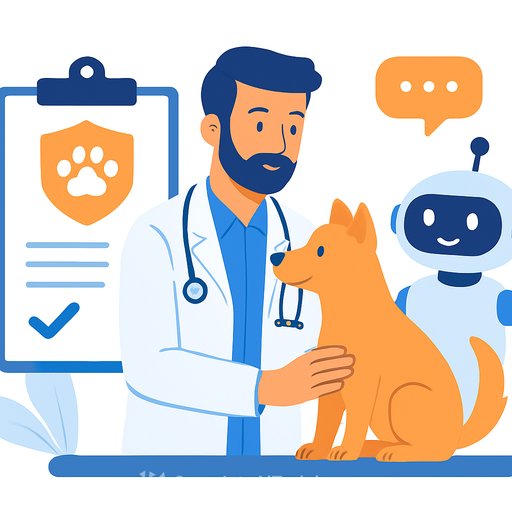Pet insurers fuel AI take-up in veterinary care
Insurers are bundling AI-driven veterinary services into pet policies to cut claims costs and improve the customer experience. The pitch is simple: faster triage, fewer unnecessary clinic visits, and better outcomes for pets.
One example is Vet-AI, which partners with insurers to provide unlimited access to vets via chat and telemedicine, backed by in-house AI models. The aim is to automate parts of the care pathway, reduce avoidable claims, and pass savings on to policyholders.
How it works for carriers
Policyholders get a subscription to a specialist app as part of their cover. They can chat with vets, book telemedicine sessions, and use AI tools that guide them on whether to manage care at home, switch to tele-vet, or go to a clinic.
Vet-AI reports half a million pets registered through four UK insurers and around 300 consultations per day. The company runs continuous delivery with about a dozen software updates daily to keep clinical content and models current.
Inside the AI stack
The service started with a rule-based symptom checker and has moved to bespoke models. Examples include gait analysis trained on roughly 20,000 dog videos and a dermatology model trained on about 80,000 tagged skin images.
For triage, the system uses base Gemini models from Google with retrieval augmented generation grounded in roughly 500,000 prior consultations. This keeps guidance close to real clinical scenarios while a human vet reviews advice before it reaches the owner.
Using VeNom Codes alongside its models, the company cites about 81% diagnostic accuracy. That human-in-the-loop step reduces risk from model errors and speeds up final advice once the right questions are already asked.
Learn more about Google's Gemini models
Why insurers care
- Lower loss costs: Early triage diverts unnecessary in-clinic visits and reduces severity through faster intervention.
- Better access: Telemedicine resolves many cases without a claimable visit, improving experience and retention.
- Operational speed: Shorter time to advice and fewer escalations cut friction and cycle times.
- Product edge: Embedded vet access differentiates policies and can support pricing flexibility.
- Richer data: Anonymized triage and outcomes data can inform case management and future underwriting signals.
Risk, compliance, and controls
- Model validation: Track accuracy vs. VeNom-coded ground truth and segment by condition, breed, and age.
- Human oversight: Require clinician sign-off before treatment guidance is issued.
- Disclosure and consent: Clear terms on what AI does, data use, and escalation to a vet.
- Clinical safety: Adverse event reporting, incident playbooks, and audit trails for advice given.
- Privacy and security: Data minimization, encryption, and compliance with GDPR and local regulations.
- Bias monitoring: Routine checks to detect and correct skew across breeds and demographics.
Implementation playbook for carriers and MGAs
- Partner selection: Assess training datasets, clinical governance, model performance, and uptime SLAs.
- Integration: Choose white-label app vs. API integration into your app; define data sharing and event triggers.
- Benefit design: Embed unlimited chat/telemedicine; set clear pathways to clinics to avoid double-handling.
- Claims alignment: Define when advice counts as a claim, payment rules for telemedicine, and referral protocols.
- Pricing impact: Quantify expected frequency and severity shifts; reflect savings in rate filings where needed.
- KPIs: Adoption rate, avoidable in-clinic visit rate, time-to-advice, cost per case, NPS, and retention.
- Governance: Model change control, versioning, audit logs, and periodic third-party reviews.
- Regulatory: Ensure clinical practice compliance (e.g., vet professional standards) and fair customer outcomes.
- Training: Equip claims teams and customer support to set expectations and guide policyholders to the app.
What "good" looks like
- ≥80% triage accuracy against VeNom-coded benchmarks in live operations.
- 20-40% reduction in avoidable clinic visits for triage-eligible cases.
- 10-25% lower average cost per resolved case through telemedicine-first pathways.
- Median time to first advice under 10 minutes; escalation-to-human rate tracked and improving.
- Clear evidence of premium stability or improved margins from lower claims costs.
Product and portfolio upside
Embedded AI triage creates a "first call" channel that steers behavior, captures early signals, and lowers claim severity. It also opens the door to wellness add-ons, proactive monitoring, and new pricing models based on engagement.
For carriers, the near-term win is controllable costs and better customer outcomes. The longer-term win is a data-rich service layer that compounds over time.
Next steps for insurance leaders
- Run a 90-day pilot with clear KPIs and a matched control group.
- Stand up governance around clinical safety, AI model changes, and customer disclosures.
- Integrate triage outcomes into claims rules and care networks to avoid leakage.
- Feed results into rating and product updates once impact on loss ratio is proven.
If you're upskilling teams on practical AI for pricing, claims, and product, explore curated options by role here: Complete AI Training - Courses by Job.
Your membership also unlocks:






